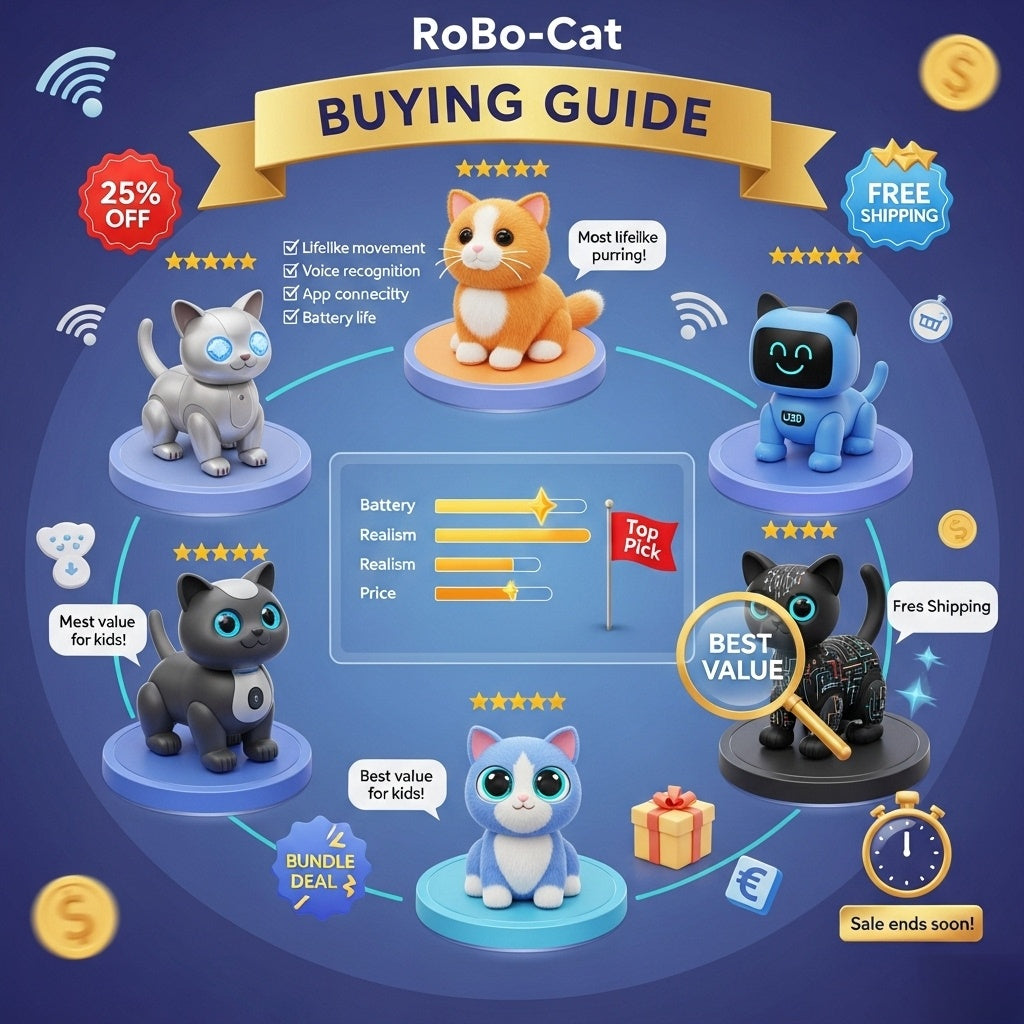Ever picture building a robot that actually listens to you, dodges stuff in its way, or grooves to your music? Honestly, that used to feel like sci-fi or something only super-smart engineers could pull off. Now? Robotics is this awesome hands-on way for anyone – kids or adults – to jump into STEM.
But let's face it: Shopping for your first robot kit? Total overload. Seriously, hundreds of choices hit you online. How do you even pick "the one" that fits you or a kid just starting out?
That's why we built this guide. We pulled together everything you need to choose the best starter robot kit, no sweat. Find one perfect for their age and skill level. Stop guessing and start building with confidence. Ready? Let's do this!
Factors to Consider Before Choosing a Robot Kit
Buying a robot kit for the first time can be an overwhelming experience. You don’t know what the best option is for you. With so many options out there, how can you find “the one”?

Here are the things to consider before clicking that “Buy Now” button:
Age
The most important thing to consider before buying a robot kit is the age of the user. A kit for a 5-year-old won’t excite a 15-year-old.
-
For kids (5-8 years old), look for something simple like LEGO Spike Essential.
-
For kids (9-12 years old), choose kits with more building options and block-based coding like LEGO Spike Prime.
-
For teens (13 and older), try programmable robots like the Makeblock Ranger.
Skill Level
Always evaluate your skill level before going for a robotic kit. If you’re a complete beginner and have no skill, then start with drag-and-drop coding like mBot.
If you have some previous coding knowledge, then go for text-based programming like Python with Makeblock Ultimate. And if you want something more challenging, then try open-source kits like Raspberry Pi robots.
Guideline and Support
Good instructions in a robot kit make the learning more interesting. Always check if the robotic kit has clear guidelines, tutorial videos, or access to an online community. It’s easier to stick with your robotic kit when you know that help is just a click away.
Price and Value
Robotic kits come in a range of prices, from $20 to several hundred dollars. The good news? You don’t have to start by breaking your bank. If you’re a beginner, then first invest in a cheaper option to learn about your interest.
Then, you can go for expensive options according to your budget. Always see what you’re getting in return for your money.
Expandability
If you want to keep learning, then check expandable robot kits. These kits let you add new parts, update software, and combine your kit with other kits. This means the robot kit will remain fun and useful as your skills improve.
Best Robot Kits By Age and Skill Level
Not all the robot kits are the same, and that’s a good thing. It really doesn’t matter if you’re buying the kit for yourself or your young kid; you should pick a kit that matches the user’s age and skill level.
Here’s a guide on how to choose a robot kit according to the age level:
Ages 5-7: Early Learners
For young kids, the goal is to spark interest and reduce their screen time. Robotic kits for this age are mostly screen-free, colorful, and very easy to use.
Through these kits, kids learn cause and effect, direction following, and logic without needing to read or code.
Examples:
-
Botely 2.0: Teaches the basics of coding without screens using only a remote control.
-
Sphero Indi: Best for preschoolers and uses colour tiles to program movement.
-
WhalesBot MakeU: Safe for building and teaching basic coding concepts.
What to Look For:
When choosing a robot kit for young kids, always consider that:
-
Robot components are not extremely tiny to avoid choking hazards. Why? For this age range, safety is first, and tiny fragments can represent a considerable risk if ingested.
-
Pieces should be strong enough to endure various fallouts. Why? Young children are still developing fine motor skills and may be less gentle; sturdy components guarantee that the kit lasts through active play.
-
Kits have easy-to-follow instructions, and there is no need for typing or reading. Why? This age group learns best through visual and hands-on methods without the barrier of complex text or screen interaction, fostering early logical thinking.
Ages 8-12: Elementary to Middle School
Children of 8-12 are ready to explore more advanced ideas like sensors, motors, and block-based coding. At this stage of fun learning, robotic kits include apps or computer programs that teach coding through challenges and games.
Examples:
-
LEGO Spike Prime: Combines 500+ LEGO pieces with Scratch-based coding for creative projects.
-
Makeblock mBot: Affordable kit with sensors and Python compatibility.
-
UBTECH Jimu Buzzbot: These are customizable robots with app-guided coding challenges.
What to Look For:
-
Kits should have interactive apps. Why? Engaging applications create a creative and intuitive environment for learning block-based coding, making complicated ideas understandable and enjoyable.
-
Robot kit projects should have clear educational goals. Why? Well-defined projects help children understand the purpose behind their builds, linking their play to concrete STEM concepts and fostering problem-solving skills.
Ages 13-17: Teens and High School Students
At this stage, more advanced options become available because teens can handle complex projects. Many enjoy learning real programming languages and building robots that can move, follow commands, or recognize objects. This is a great time to introduce Python, Raspberry Pi, and Arduino.
Examples:
-
Makeblock mBot Ranger: 3-in-1 robot with Python support for serious coding lovers.
-
Raspberry Pi 4 Starter Kit: Teaches Python, Linux, and electronics to engineering lovers.
-
Petoi Bittle: Open-source quadruped robot for AI or robotic lovers.
What to Look For:
-
More open-ended kits. Why? Teens are ready to move beyond controlled tasks and enjoy the flexibility to develop, invent, and personalize their products, which fosters more engagement and creativity.
-
Hands-on coding. Why? Direct interaction with true programming languages like Python or Arduino provides valuable hands-on experience that builds the groundwork for future computer science or engineering initiatives.
-
Kits that support problem-solving. Why? Challenging tasks foster critical thinking, resilience, and the application of acquired principles to overcome barriers, which match real-world engineering challenges.
-
Robotic kits with an online help forum. Why? Teens may seek answers, exchange ideas, and cooperate with peers and professionals, which improves their learning experience and fosters independence.
Adults and Hobbyists
Adults can also play with the robotic kits to learn new skills or just to have fun. There are several robotic kits on the market for beginner adults. Advanced kits are also available for skilled people.
Different kinds of robot kits are available, such as humanoid robot kits, robotic arm kits, etc.
Examples:
-
OSOYOO Robot Car Kit: It is an Arduino-based robotic kit. Due to its complexity level, it is considered one of the best for adult beginners.
-
Robotis Bioloid Premium: A more advanced and technical kit for skilled people.
What to Look For:
-
Clear guidelines and tutorials. Why? Even experienced adults value well-structured tools that enable them to swiftly comprehend new concepts and easily fix challenges, therefore optimizing their learning time.
-
Expandable kits with upgrade options. Why? For long-term involvement, the option to add additional components or interact with other systems keeps the kit current and challenging as abilities develop.
-
Online communities for assistance. Why? Connecting with other enthusiasts gives an opportunity to share advanced skills, debug complicated problems, and get ideas for new projects.
Common Mistakes to Avoid When Choosing a Robot Kit
When buying your first robot kit, it’s easier to get excited by the flashiest and most advanced option. Many beginners make easily avoidable mistakes that turn a fun learning experience into a pricey paperweight.
Here’s what to watch for:
Buying a Kit That’s Too Advanced
If you’re a beginner and you pick the most advanced robotic kit with C++ coding, then your fun learning experience will quickly turn into a frustrating one. When starting, pick beginner-friendly or starter kits to learn. First, learn the basics and then move up to more advanced kits.
Ignoring Age Recommendation
Robotic Kits are designed keeping in mind the age of the users. Giving a 5-year-old a Raspberry Pi robot is like giving him a calculus book; he’ll quickly lose interest.
Therefore, you should buy the robotic kit by considering the age and attention span of the user. Young kids need instant results (Botley 2.0) while teens want customization (mBot Ranger)
Forgetting About Software Compatibility
Though most of the robots are compatible but some robots are also present in the market that don’t work with Mac, Chromebooks, and older PCs. For example, robotic kits like Sphero work with Android, and Arduino need USB ports. Therefore, always check system requirements before buying a kit.
Assuming Expensive is Equal to Better.
Many beginners fall into the trap of buying expensive robots because they think a higher price means a more advanced robot. This is the wrong mindset. First, check robots in the $50 to $100 range, and after testing, consider splurging on more advanced and pricey options.
Overlooking Support and Guidelines
A good robotic kit typically comes with clear instructions, tutorials, and apps to guide you. If the manual has no clear guidelines or tutorials, the setup and use of robots will be a real headache.
Always look for a robotic kit with positive reviews, community help, and plenty of YouTube tutorials. These resources make learning a fun experience.
Not Planning For Upgrades
A one-and-done kit becomes boring after a while. This means you need a new robot kit. Instead of purchasing different one-and-done robotic kits again and again, invest your money in modular systems (Like Makeblock Ultimate) where you can add robotic accessories like sensors, cameras, or even AI later. These types of kits grow with you.
By avoiding all these pitfalls, you can build, code, and have fun without annoying headaches.
Tips For Getting Started With Your Robot Kit
As a beginner, it's an exciting thing to buy a new robot kit. But it's a bit confusing too for the first timers. Here are the necessary tips for getting started with your new robot kit as a beginner:
-
Don’t try to do everything in a rush. Read the manual carefully and start with the basic project that comes with the kit. This will assist you in understanding the procedure and how things work in the robotic world.
-
If you’re stuck at a point for a long time, look for YouTube videos or search the company’s website. Seeing someone else making a robot makes the concept easier to understand.
-
There are many online forums and communities where people regularly share tips, shortcuts, and answer questions related to robots. Try to join these helpful online channels.
-
Remember, in the robotic world, there is no wrong way. After understanding the concept, do experiments with your robots.
Conclusion
Playing with robotic kits can open a whole new world of creativity and learning for you. Over time, you will start learning coding skills. It doesn’t matter if you’re just starting or a master in this field; there’s a perfect robot kit out there for you. Always remember to select the kit that matches your interest, take your time, and enjoy the process.
FAQs
What’s the Best Robot Kit for a Complete Beginner?
For beginners, the robotic kit named Makeblock mBot is ideal. It’s affordable, uses scratch-based coding, and has pre-programmed modes for instant fun. And for younger ones, Botley 2.0 is perfect, which teaches coding without a screen.
Can Adults Use Beginner Robot Kits?
There are many robotic kits for adults on the market. Kits like Arduino-based robots and Raspberry Pi kits are perfect for those who want to learn from scratch. They offer more depth while still being beginner-friendly.
Do Robots Teach Real Coding?
Absolutely, robots teach you real coding. Beginner kits mostly use block-coding (Scratch), and advanced kits like mBot Ranger support Python and C++. Some kits, like Ozobot Bit, can even mix physical play with simple coding concepts.







